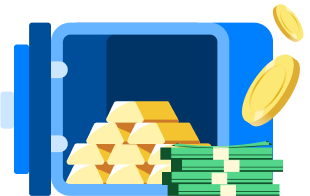
Table of Contents
Modified On:
Having a strong financial roadmap can mean planning for long-term success and short-term goals. A strong roadmap allows individuals to identify goals and set realistic timelines. Learn more here!
It feels like every other commercial on TV these days is about financial strategies. And while it can be tempting to seek professional help in creating a financial roadmap to financial well-being, doing so is not always necessary.
There are three qualities that all solid financial plans share, and we can easily draft a strong financial roadmap to financial well-being for ourselves.
What is Financial Well-Being?
Financial well-being is characterized by the ability to manage current and future financial needs fully. It involves having access to income, savings, protection from economic shocks, and making informed money decisions. Financial well-being requires both short-term management of finances and long-term planning for future goals.
A secure financial base allows people to pursue their dreams, such as starting a business or buying a home. Additionally, having adequate resources can help reduce stress and improve overall mental health and quality of life. Health and financial wellness also plays a huge role in keeping us happy.
To achieve financial well-being, we must have access to income sources, an understanding of basic money management concepts, the ability to save for future expenses and goals, manage debt, and make informed financial decisions.
Additionally, we must have access to appropriate resources such as banking services and credit options and understand how to protect ourselves against economic shocks.
How Can a Person Achieve Financial Well-Being?
Achieving financial well-being can be a long and difficult journey that requires dedication, self-discipline, and hard work. However, the rewards of becoming financially secured are worth it. Here are some tips for achieving financial well-being:
1. Set Financial Goals
Setting realistic goals is the first step towards achieving financial well-being. We need to ensure that our goals are achievable in terms of time frame, resources available at our disposal, and degree of difficulty.
2. Budget
Establishing a budget allows us to track our spending habits and create a plan for allocating money toward bills and other monthly expenses. Tracking income and expenses also allow us to identify areas where we may need to cut back or adjust our spending.
3. Save
Saving a portion of our monthly income can help build up a financial cushion in case of emergencies or unexpected expenses. Setting aside even small amounts of money regularly can add up over time and help provide future security.
4. Invest
Investing is an important part of achieving financial well-being as it allows for long-term growth and potential appreciation in value for our money. Research different types of investments and consider consulting a professional before making any investment decision.
5. Protect Yourself Financially
Ensure that you have adequate insurance coverage, such as life insurance and health insurance, to protect yourself financially should anything unexpected happen. Additionally, consider preparing a will and power of attorney to protect assets and provide for the family.
Following these steps can help us to achieve financial well-being, allowing us to live with greater security and peace of mind. Financial wellness and mental health correlate with each other. But, with dedication, hard work, and smart decisions we can create the future we want for ourselves.
3 Qualities Of A Strong Financial Road-map
A strong roadmap to financial wellbeing is key to setting oneself up for success. Here are three essential qualities of a successful roadmap:
1. Planning
A good plan should provide an overall view of how we want to manage our money over the short and long term. This could involve planning for retirement or other goals, such as saving for college, buying a house, etc. It's important to look at the big picture regarding finances to ensure that all pieces fit together properly.
After factoring in their timelines, we can have different investments based on our goals. This will also give us a strong bandwidth to deal with unforeseen expenses/roadblocks.
2. Flexibility
The best plans allow room for change and growth based on our circumstances. That means being able to adjust our plan according to changing needs or unexpected expenses. Life can throw curve-balls, and we need to be prepared for that to succeed financially.
It is also important to evaluate our investment and savings plan from time to time and make desirable changes if necessary. If a particular investment is under performing consistently, regular monitoring will allow us to save time or explore other available options.
3. Debt Management
It is imperative to note that not all kinds of debt are bad. For instance, a home loan can help build equity and boost our credit score. On the other hand, high-interest consumer loans or credit cards heavily impact our credit ratings.
It is important to create a debt management plan that helps us pay off our debts as quickly and efficiently as possible.
With these three qualities in place, we will have a strong foundation for achieving financial well-being and reaching our goals. Remember, this isn't something that happens overnight; it takes time and dedication to build a successful road-map, but the rewards are worth it in the end! We can find the path to financial freedom with careful planning and dedication.
Conclusion
Achieving financial well-being is possible for anyone who takes the time to create a road-map and follow it. Our financial road-map must have the 3 essential qualities that are necessary for success - Planning, Flexibility, and Debt Management.
Remember, it's important to take things one step at a time and celebrate each accomplishment.
Do you also want to achieve financial well-being but find it difficult? Try the Jar App. It helps to automate daily savings into gold starting with as low as INR 10. So, what are you waiting for? Achieve Financial Success with Jar App.

Save Money in Digital Gold

.svg)







.png)
.png)












.jpg)

